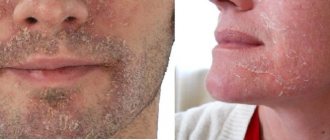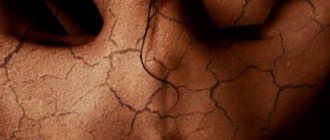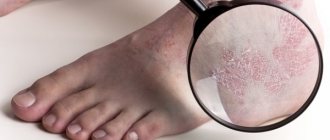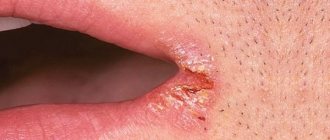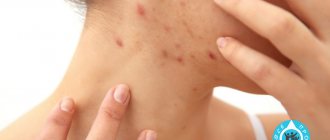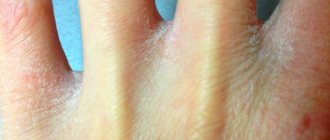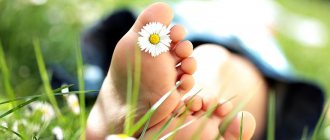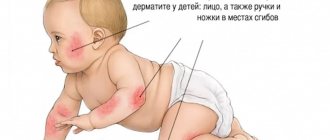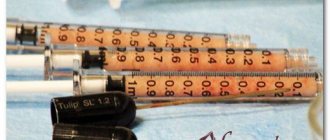CAUSES
The reasons when a child has cracked skin on his fingers are divided into external and internal.
External ones include:
- excessive exposure to ultraviolet radiation or low temperatures;
- contact with an allergen (contact dermatitis), that is, a reaction to household chemicals, for example, poorly rinsed laundry, or products used in child care, for example, diapers, creams, shampoos.
You should remember or check whether the washing powder, soap, baby cream and other products with which the child comes into contact have been changed, and whether the hands are frozen or chapped.
Skin allergies in a child
If the problem is caused by external factors, then you just need to protect the child from adverse effects and help the skin recover. To do this, keep your hands in baths with celandine, string, chamomile, and then generously lubricate them with baby cream.
Internal reasons are a little more complicated, these include:
- allergic diseases, including allergic and atopic dermatitis, eczema. Up to the age of five, allergies can manifest themselves to foods such as chocolate, milk, citrus fruits, or to flowering plants, dust, or animal hair;
- diseases caused by fungus. The risk of a child contracting a fungal disease increases when visiting bathhouses, swimming pools, water parks, and also if someone from the immediate environment has this disease;
- parasites. When scabies occurs, the fingers and hands are the first to be affected. In this case, in addition to cracking of the fingers, there will be severe itching, which is especially disturbing at night or in the evening, and also decreases in the cold;
- an infectious disease. Cracking and peeling of the fingers is a symptom of scarlet fever; moreover, with this disease, the skin literally peels off the fingers.
- specific skin diseases (psoriasis, ichthyosis, lichen), in which cracking of the skin on the fingers can also be observed;
- Staphylococcus aureus, which often manifests itself as a complication of any disease in infants;
— enteropathic acrodermatitis (vitaminosis), which manifests itself as a result of a lack of vitamins and microelements in the body;
- psychological problems. In children, skin manifestations of this type may occur as a result of psychological discomfort, for example due to a change in environment or some unpleasant incident for the child.
If a child has cracked skin on his fingers for any internal reason , you need to show the child to a doctor, especially if you find concomitant symptoms of serious diseases. That is, before treating a child’s fingers for cracks, it is necessary to cure the cause of their appearance.
Causes of cracks in the skin
The most likely reason for the formation of cracks is a weak protective skin barrier , which is not able to withstand an aggressive external environment. It consists of oils, proteins and other substances that help the skin from drying out and becoming very rough.
The most likely external causes that lead to the disappearance of the skin barrier can be considered:
- exposure to the cold without gloves;
- frequent overheating in the sun;
- sudden changes in temperature;
- dry indoor air;
- frequent contact with harsh chemicals or detergents;
- using care products that have expired.
If the main factor for dry skin is one of the external irritants, then shallow cracks will appear on the hands. In this case, damage does not occur between the fingers and at their tips.
However, there are a number of internal factors that affect the condition of the skin:
- skin diseases of infectious and non-infectious etiology;
- metabolic disorders;
- a number of endocrine diseases;
- allergic reactions;
- poor nutrition, which leads to a lack of vitamins and minerals;
- diseases of the digestive tract;
- Schegner's or Reiter's syndrome;
- age-related changes.
The main place of localization when exposed to internal factors is the area between the fingers, fingertips, and palms. Gradually the number of cracks increases and they spread throughout the arm.
In order to choose the right therapy , you need to establish the main cause that caused peeling and dry skin. Only after it has been eliminated will it be possible to begin complex treatment of the problem.
AS A PREVENTION
Don't neglect daily hygiene procedures
To prevent and prevent cracking of the skin on children's fingers, experts recommend:
- organize a balanced diet for the child;
- do not neglect daily hygiene procedures;
— timely diagnose and treat diseases.
Find out right now about the most useful drug Plantex for newborns (instructions for use). For colic, constipation, bloating, regurgitation and to normalize digestion.
Why do my child's fingers crack?
Reasons why a child’s fingers peel off
According to statistics, people with a similar illness most often turn to a pediatrician during the cold season, when it is not difficult to detect and understand the cause. Sometimes the skin on the fingers of a child cracks and peels off as a result of hypothermia. The baby's delicate skin is more susceptible to temperature changes. This is especially true for infants and children of the first year of life. In this case, the doctor prescribes an ointment to moisturize the hands and it is recommended to keep them warm. But the symptoms may not always indicate banal hypothermia of the skin.
If your baby, in addition to the symptoms of peeling fingers, has parallel ailments, you should pay careful attention to them. It is possible that the cause is a serious illness.
Skin peeling and peeling on a child’s hands can result from the following factors:
- Dysbacteriosis is one of the reasons leading to disruption of the dermal layer. This happens due to body intoxication and dehydration. As a rule, dysbiosis is accompanied by a slight increase in temperature, bowel movements (diarrhea), nausea or vomiting. The child may experience severe weakness, aches throughout the body, and pain in the abdominal area. In such a situation, you should seek help from your treating pediatrician. You may need to be hospitalized for inpatient treatment.
- Stress sometimes becomes an impulse to change the condition of the skin. It’s not for nothing that they say that all diseases are caused by nerves. If the baby reacts sensually to surrounding circumstances, he is more affected by negative aspects. Than other guys, you should pay attention to his psychological state. Perhaps due to nervous and emotional fatigue, an outburst, the body reacts to what is happening in a similar way.
- Allergy. It can arise due to many factors. The younger the baby, the more situations in which peeling of the fingers is possible. For example, allergies to food, synthetic items (gloves, mittens, jacket), bed linen, cosmetic care products, chemicals (powder, shower gel, hand soap) can lead to such symptoms. Parents need to pay attention to whether anything has changed in the child’s life recently; perhaps new things have been purchased, a new product has been introduced.
- Fungal infection. Such skin diseases include mycoses, pityriasis versicolor, microsporia, candidiasis, favus. Parents can independently recognize a lesion of this nature. They are often accompanied by increased symptoms. If the skin initially peeled and peeled, then strange manifestations began to appear in the form of pimples, redness, pimples, ulcers, etc., you should consult a dermatologist.
- In children under 3 years of age, diaper rash is often the cause of skin peeling and peeling. It can be recognized by the appearance of specific red or pink small spots, or one large red spot. As a rule, when using products such as Bepanten, Calendula ointment, and air baths, the disease goes away on its own. If after a week the symptoms do not go away, you should consult a doctor; perhaps the cause lies in a more serious pathology.
- Vitamin deficiency is a banal situation in which a violation of the skin on the arms, legs, back, and abdomen occurs. Only a doctor can determine the lack of vitamins after undergoing tests and examining a small patient. Under no circumstances should you buy or prescribe a course of vitamins for your child. Sometimes inappropriate use can lead to hypervitaminosis, which can lead to more severe pathologies, including formations of various types.
- According to statistics, parasitic infection in children from 3 to 7 years old becomes a common cause of skin problems. This arises due to the child’s introduction into society - a kindergarten, where the child is not always under the close attention of an adult, but also actively learns about the world around him. A banal game in the sandbox can ultimately lead to infection with helminths. Associated symptoms will manifest themselves in the form of abdominal pain, weakness, abnormal bowel movements, and itching in the anus. If at least 2 signs are observed, it is worth showing the baby to an infectious disease specialist or parasitologist.
As medical practice shows, there can be many reasons for skin disorders on the hands; the main thing is to notice the disease in time and monitor its manifestations and accompanying signs.
Treatment - what to do, what to apply and how to restore
Treatment will directly depend on the diagnosis, so before starting therapy, you should carefully observe the child and try to identify the problem yourself.
Attention! You should not start self-medication if your baby has serious concomitant ailments such as fever, severe abdominal pain, and vomiting. In such a situation, you must urgently seek help from a doctor. He will make the correct diagnosis and prescribe adequate treatment.
The table below will tell you what to do in other situations that do not require emergency medical care.
| Dysbacteriosis | When parents are absolutely sure that the cause of the disease is dysbacteriosis, they can help the child on the first day if the symptoms are not acute. This will help reduce the likelihood of further development of the disease. Doctors recommend giving the following drugs: “Linex”, “Bifidumbacterin”, “Polysorb”, and using bifidokefirs in children. They will help improve and restore intestinal microflora. At the same time, monitor the condition of the stool, drink a large amount of water mixed with Regidron to improve the salt balance. To improve the skin on your hands in this situation, you can use Bepanten, Dexpanthenol, Children's cream. The main thing is to eliminate the cause of the disease, that is, dysbiosis. | Gastroenterologist, pediatrician. |
| Stress | Parents can talk with the baby, find out the cause of the disorder, and try to calm the baby down. Such remedies help to put the child’s nervous system in order. Like Glycine (for severe stress), herbal teas based on calming plants. It is advisable to show the child to specialists. For hands, you can use baths with string, chamomile, and calendula. Afterwards, lubricate them with moisturizer. | Neurologist, neuropathologist, pediatrician, psychologist. |
| Parasitic infection | When a baby experiences itching in the anal area and abnormal bowel movements, we can speak with 80% certainty about a parasitic infection. In such a situation, you can perform microenemas based on wormwood (a weak solution) at home and drink Vermox, Wormil, Intoxic according to the instructions according to your age. To alleviate the condition of the hands during treatment, you can use baby cream, Bepanten, Dexpanthenol. | Parasitologist, infectious disease specialist. |
| Avitaminosis | In this matter, it is worth contacting a specialist, since uncontrolled use of vitamins can lead to a number of problems. If the doctor determines vitamin deficiency, then a multivitamin complex will solve the problem in a short time. | Pediatrician. |
| Allergy | To eliminate peeling hands caused by allergies, it is worth giving the child an antihistamine. Today, Finestil, Zodek, Zyrtec drops are popular. The skin will stop peeling after about 3-7 days of treatment. The average course of antihistamines is 3-5 days. You can additionally use herbal baths and moisturizers. The main thing is to remove the irritant that causes the allergic reaction. | Pediatrician, allergist. |
| Intertrigo | For diaper rash, Bepanten ointment, Dexpanthenol ointment, and Calendula ointment help well. The product is applied 2 - 3 times a day to the affected area. You should carry out air baths, make baths based on string, chamomile, and calendula. | Pediatrician, dermatologist. |
| Fungal infection | Antifungal ointments are used in therapy: Exoderil, Termicon, Haloprogin, Lamisil. | Dermatologist. |
Note! Pediatricians do not recommend carrying out antifungal therapy on your own. To determine an effective drug, it is worth undergoing examinations. Self-medication may not give positive results.
Prevention of peeling and cracking on the hands and arms of children
To avoid peeling and cracking on your child’s hands, you should follow a number of simple rules. They will help avoid unpleasant symptoms and help keep your hands beautiful and healthy.
Preventive measures include the following:
- prevent hypothermia of the hands (in the cold season, wear gloves and mittens according to the season);
- monitor hand hygiene (wash after every walk or visit to a public place);
- conduct vitamin therapy courses together with the pediatrician (they are usually necessary in spring and winter);
- feed the baby correctly (up to 3 years old, introduce new foods with caution, then minimize the consumption of sweets, fatty foods, starchy foods, increase plant foods);
- visit specialists on time;
- playing sports, general strengthening of the body, hardening.
These simple rules will help you avoid hand skin problems for a long time. When the first signs of peeling are detected, moisturizing creams should be used. If they do not give a positive result, look for the problem and carefully monitor the general condition of the baby.
Home Children's health A child has cracks on his fingers: what is the reason?
A child has cracks on his fingers: what is the reason?
Parents often notice that their child has cracks in his fingers.
arms or legs. This skin condition is very painful.
The resulting cracks serve as entry points for infection and often end in suppurative processes.
The causes of cracks are varied.
- Disturbance of trophic processes in the skin.
A lack of complete animal protein in food leads to a decrease in the amount of connective tissue and the skin loses its elasticity.
As a result, cracks appear during movements.
Nutrition correction is carried out by increasing the content of foods with a high collagen content in food.
In children, they occur as a result of wearing tight or inappropriate shoes.
Constant friction of individual areas of the skin causes a violation of the integrity of the skin.
In this case, baths made from decoctions of medicinal herbs are the best way to get rid of cracks.
Marigold and chamomile flowers (40 g) are steamed with two glasses of boiling water, then mixed with a liter of warm water. After a 20-minute bath, the cracks are lubricated with sea buckthorn oil or rosehip oil.
A reduced amount of B vitamins, vitamins A and E in food leads to metabolic disorders and cracks in the epidermis.
The cracks become gaping and muscle tissue is visible through them.
Aevit is used in capsules, neurorubin in tablets.
The diet should be enriched by increasing the content of eggs, liver, spinach and nuts.
Increased blood sugar leads to dry skin and mucous membranes due to the evaporation of large amounts of moisture.
In this case, the use of SixtuMed oil gives a good effect.
Cracks are accompanied by redness, peeling, and the formation of scales.
Often a specific smell is attached.
Antifungal ointments (clotrimazole, lamisil) are used for treatment.
The cracks are lubricated with glycerin with the addition of tea tree oil (5:1).
Bleeding cracks and itchy rashes appear near the finger joints.
Treatment is complex and includes antihistamines (suprastin, tavegil) and ointments with corticosteroids.
The drug Acroderm has been successfully used.
Some types of soap and washing powders are not suitable for washing mittens and socks.
First they cause dry skin, then cracking.
Lubricating the skin with bepanthen and heated olive oil usually gets rid of cracks.
Psoriatic plaques, when localized in the interdigital area, violate the integrity of the skin.
Treatment should be individual and comprehensive, consisting of sedatives and antiallergic drugs, vitamin therapy and hormonal drugs.
Ointments used include sinalar and fluorocort.
In general, the treatment of cracks in a child’s fingers depends on the cause that caused them.
Treatment options
Dry facial skin
The problem of dry skin has various solutions. Most often, a dermatologist will help eliminate it quickly and competently. To do this, you need to determine the reasons for its occurrence. If dry skin occurs due to contact with household chemicals, you should wear gloves when doing housework and smear your hands with moisturizing creams. If dry hands are the result of a malfunction of the body's internal systems, drug treatment should be taken.
Medicinal ointments and creams
For your information. Today, on pharmacy shelves there are a lot of different creams that are not medicines, but contain vitamin supplements.
These creams can help in the initial stages of dry hand skin. If the cause of dryness is contact with household chemicals or chapping, these products can help, but if the problem lies in genetics, then they can be used as an additional cosmetic product when caring for hands and palms.
Drug treatment
For your information. When undergoing the necessary tests to identify the cause of chapped skin, the dermatologist, after receiving the results, may prescribe medication.
Basically, these medications are used to eliminate infectious diseases, as well as to treat fungal infections. A dermatologist can prescribe a variety of vitamin complexes, which, when consumed, will quickly heal and restore the hands.
Cosmetical tools
Cosmetic products designed to eliminate the problem of dry skin on the hands come in several types:
- Silicone – have a softening and moisturizing effect. In combination with glycerin, the effect is noticeable faster. Silicone cosmetics do not clog pores, do not violate the integrity of the skin, and cover the epidermis with a protective layer.
- Regenerating cosmetics. Promote the regeneration of damaged cells and the appearance of a protective layer on the upper layers of the epithelium.
- Healing creams - designed to quickly get rid of cracks and renew the cells of the upper layer of the dermis.
- Nourishing – used in the initial stages of hand skin disease. They saturate the dermis with missing minerals and vitamins, and also moisturize it well.
- Hydrophobic - used mainly in contact with household chemicals. Promote the formation of a thin film that covers the entire surface of the brushes, creating a protective barrier.
Salon treatments
For your information. Salon procedures include masks for brushes according to folk recipes, which are made by a cosmetologist.
Masks are divided into several types:
- Honey mask with added silicone. Apply to the skin, rub in and leave under a thin cotton layer for 20 minutes.
- Mask made of glycerin, vitamin B1. The components are mixed in the required proportions and applied to the skin. It is recommended not to wash off the mask for 15 minutes. During this time, vitamins can penetrate into the deep layers of the dermis, nourishing and restoring them.
Treatment for cracked skin on fingers
Not only women, but also many men often complain that the skin on their fingers becomes rough and cracks appear on it, causing discomfort and even pain. There are many reasons why this happens, but you should know that there is an effective treatment for cracked skin on the fingers. Having noticed that the skin on your fingers has begun to harden, you must first figure out what caused these symptoms.
Hands are known to be a calling card, especially for women. Sometimes even increased care for them does not save them from cracks that form due to working with household chemicals, detergents and cleaning products, due to the fact that the skin of the hands is exposed to the cold and frost. In addition, treatment of cracked skin may be required if there is a clear lack of nutrients and vitamins, in particular A and E. In winter and spring, this shortage is especially severe because the body lacks fresh fruits, vegetables and herbs.
Often a dangerous fungus appears on the fingers, which also causes skin damage and cracks. Few women know that due to serious hormonal imbalances, cracks can also appear.
Diseases that can cause cracking of the skin on the hands are neurodermatitis and psoriasis. All this is not entirely harmless and safe, as it might seem at first glance.
Diseases of the digestive system and disorders of the gastrointestinal tract can lead to cracking of the skin in the areas between the fingers. In addition, thyroid dysfunctions that appear with age may manifest themselves in this way. Often similar symptoms can be observed in those who suffer from diabetes, with low hemoglobin levels. To identify such violations, it is necessary to undergo regular examinations.
Treatment of chapped skin may be completely ineffective if the effects of external irritants are not eliminated in a timely manner.
There are basic rules to prevent cracking on your fingers. First, you should wear gloves when washing dishes, cleaning the house, or working with toxic or chemical substances. When washing, it is better to use soap intended for sensitive skin with a softening effect. After washing your hands, you need to thoroughly dry them, especially the areas between the fingers, because this is where moisture can remain, which is dangerous for the skin. Twice a day or more often you need to use a hand cream that has a softening effect.
When going outside in the cold season, be sure to wear gloves, because cold is one of the main factors affecting the skin of your hands. It is recommended to take preventive baths every day at home. Oil obtained from wheat germ, almond oil, olive oil or apricot oil are added to warm water. These oils contain vitamin E, which is so useful for moisturizing the skin of the hands.
You can simply lubricate your hands with cedar oil, wrapping them with a linen napkin on top. This mask has a beneficial effect on the skin, softening and nourishing it.
At home, treatment of chapped skin on the hands can be carried out using a medicinal composition of milk, starch, glycerin and warm water. All components must be mixed well until smooth, dip your hands into the resulting solution, and hold for ten minutes. After such procedures, cracks on the fingers will gradually soften and heal.
Another mask that helps heal cracked skin on the fingers is a mask of boiled potatoes, crushed with sunflower or olive oil.
Those who suffer from frequent cracks in the skin of their hands are advised to diversify their diet by including nuts, fresh fruits and vegetables, herbs, olive oil, and carrots.
In folk medicine, mixtures of herbs are popular. So, you can prepare a collection: string, chamomile, calendula, plantain. Take all components in equal parts, chop, brew with boiling water, and leave to brew for seven to eight hours. Add a little butter and honey to the finished mixture, mix well and apply the resulting composition to the skin of your hands, lightly rubbing it into the sore areas.
At home, you can treat chapped skin using rose petals. For such medicinal purposes, it is advisable to use a rose that has grown in your own summer cottage. Petals of a fresh flower are ground to make a paste and mixed with lard (1 tbsp). Before use, leave the ointment for several days in a dark place, then lubricate your hands, putting on cloth gloves on top.
A traditional folk remedy is masks made from rye bread. The crumb needs to be thoroughly soaked in warm cow's milk to form a liquid paste. The resulting product should be applied to the skin of the hands, wrapped in a bag on top, and left for half an hour. After this, remove the mask, rinse your hands in warm water, dry your skin with a paper or linen towel, and lubricate with nourishing cream.
To prevent the formation of cracks, it is necessary to arrange home cosmetic procedures at least once or twice a week. They will produce a moisturizing effect, soften the skin, preventing it from cracking. Try to regularly treat your hands with nourishing creams, changing them periodically to avoid addiction.
A quick way to heal rough and cracked skin on your fingers is to use mumiyo. A couple of tablets must be dissolved in warm water or milk to form a paste-like composition. Treat the skin on your hands with this product, thoroughly lubricating the areas between your fingers.
If the cause of cracks in the fingers is any disease, then you first need to cure it.
Herbal baths
- scabies
- allergy
- candida
- dry eczema
If a child's skin peels off his toes or hands, you can make baths with herbs: celandine, string or false collection. After the procedure, you need to blot the skin with a soft towel. Do not use products made of hard material and do not rub the skin thoroughly.
Dry fingers need to be lubricated with cream to moisturize. This could be an oil solution or a multivitamin.
- Skin fungus, infections. This is how herpes and allergies can manifest themselves.
- Manifestations of diabetes and other diseases of the endocrine system.
- Dry air in a room where a child spends a lot of time. Most often, children suffer from this in winter, that is, during the heating season. Children from families that have individual heating are also susceptible, because parents often think that the child is cold.
- The skin between the toes on the feet may peel off due to wearing low-quality shoes that do not breathe, which means the toes become steamed.
- The use of cosmetics, such as creams, that are not suitable for the baby’s age.
- Very warm socks and shoes. In such a situation, the skin steams and sweats.
- Nervousness, mental tension.
- Visit to a swimming pool with chlorinated water. Bleach dries out the skin, which leads to flaking and peeling. This occurs in children if they constantly visit the pool.
Most often, the skin peels off between the toes, because it is the lower extremities that can steam and then quickly cool down. You are more likely to catch a fungus through your feet.
If your son or daughter has peeling dermis between the fingers and/or toes, special care needs to be carried out, it consists of the following steps:
- Every evening, before bed, in addition to bathing, you need to provide your baby with salt baths for 15-20 minutes. In addition to salt, you can add a couple of drops of essential oil. An excellent solution is lavender. After all, it can ease the condition of the skin and calm the baby.
- The skin in places where peeling can be cleaned with a gentle pumice stone, so as not to damage the integrity of the skin. The pumice stone should be fairly fine.
- After this, the skin between the toes should be lubricated with rich baby cream, put on natural, preferably cotton socks, and put to bed. During the daytime, it is best for the child to walk barefoot on the floor, if the temperature of the surfaces and the room allows this.
- During the entire period while the skin is peeling off and during such home treatment, you cannot use washing gels and similar cosmetics, even for children. You can wash your baby using laundry soap.
Scabies
As scabies develops, it goes through the stages of redness of the skin, the appearance of pimples and scabies. It is recommended to treat the disease in a hospital due to the speed and ease of its spread.
Eczema
The cause is a disruption in the production of hormones, weakened immunity and due to hereditary predisposition. The symptoms are similar to those of scabies, with the exception of the formation of pimples and scabies.
For treatment, special creams, medicinal ointments and a strict diet are used. For a complete cure, visits to several doctors are most often required.
It will require 1 liter of soft water (melt, cooled, boiled or filtered tap water) and 1 tbsp. l. starch. It is recommended to keep your hands in the resulting solution for 15 to 25 minutes, after which they should be wiped dry and lubricated with a nourishing cream.
At the end, you need to rinse your hands with warm water, dry them with a soft towel or in the air and lubricate them with skin-nourishing cream.
To create it, various natural ingredients are used: celandine, string, currant leaves, oak bark and others. The decoction obtained by boiling the mixture is cooled to an acceptable temperature and hands are immersed in it for half an hour. Afterwards, gently dry the skin with a soft towel and apply a non-greasy cream to it.
Oatmeal bath
To prepare it you will need 1 tbsp. l. with a heap of oatmeal, 1 tbsp. l. honey, 1 glass of water and 1 tbsp. l. kefir, fermented baked milk or 2 tbsp. l. milk. The oatmeal is poured with boiling water, after which it has cooled, the dairy product and honey are added.
Hands should be kept in the mixture for 15-30 minutes, and after rinsing with running water, apply the cream.
Why do my fingers crack?
Despite the fact that the skin on the hands looks soft and delicate, it serves as good protection for the hands from the influence of various external factors. Our hands come into contact with various chemicals, dirt, dust, endure different temperature conditions and are subject to strong friction, while they are absolutely unprotected. In order for our hands to always remain in excellent condition, it is necessary to take care of them.
Another common problem is cracked fingers - first the skin on the fingers becomes dry, then cracks appear. Some cracks heal over time, but deeper ones can also form; their healing is so simple and can take more than one year. Typically, cracks appear on the pads of the fingers, in the skin between the fingers, or on their phalanges. Remember, no matter where cracks appear, you must immediately treat the skin of your hands.
Of course, you can turn to traditional medicine, but the surest way is to consult a dermatologist, he will help you identify the causes of skin disease on your hands, and then prescribe the appropriate medications.
What are the causes of cracks in the hands? Often cracks appear due to the fact that hands are in constant contact with chemicals and water. When cleaning, dust gets on the skin of your hands. If we don't wear mittens or gloves during the cold season, cracks also appear on our hands. Another reason is a lack of vitamin B, various fungal diseases or allergies to new cosmetics.
you can care for the skin of your hands with expensive cosmetics, or you can use decoctions of medicinal herbs such as chamomile, nettle, etc. Choose soft soap, maybe baby soap. During the day, apply a rich cream to your hands, but only wash them first. Before going to bed, use night hand cream and cotton gloves.
In order to avoid cracks in your hands in the future, remember that your hands need daily care, your body needs to take vitamins and eat the right foods.
Sources: No comments yet!
What to do when the skin on your hands dries during pregnancy
Your hand skin will be less dry if:
